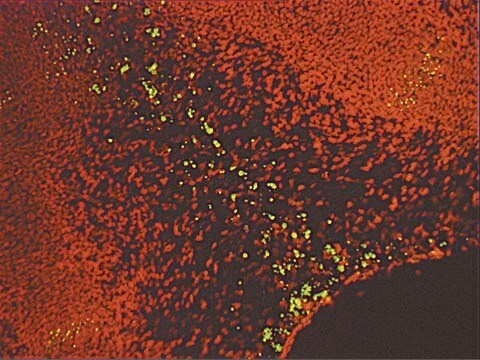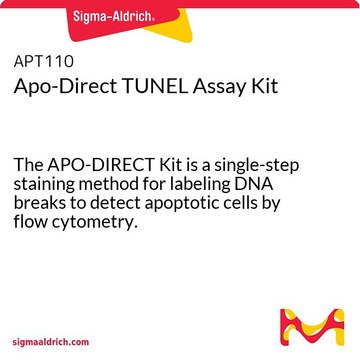APT1000
ApopTag ISOL Dual Fluorescence Apoptosis Detection Kit (DNase Types I & II)
The ApopTag ISOL Dual Fluorescence Kit utilizes a proprietary double hairpin, dual fluorescently labeled oligonucleotide labeling process to detect & distinguish between typical apoptotic DNA breaks induced by either DNase I or DNase II.
Anmeldenzur Ansicht organisationsspezifischer und vertraglich vereinbarter Preise
Alle Fotos(2)
About This Item
UNSPSC-Code:
12161503
eCl@ss:
32161000
Empfohlene Produkte
Speziesreaktivität (Voraussage durch Homologie)
all
Hersteller/Markenname
ApopTag
Chemicon®
Versandbedingung
dry ice
Allgemeine Beschreibung
The ApopTag ISOL Dual Fluorescence Kit utilizes a proprietary double hairpin, dual fluorescently labeled oligonucleotide labeling process to detect and distinguish between typical apoptotic DNA breaks induced by either DNase I or DNase II enzyme activities. The Vaccinia Topoisomerase I mediated ligation reaction is adaptable for staining paraffin-embedded tissue, frozen tissue sections, cell suspensions, and adherent cells. In situ staining for DNA fragmentation (as in the ISOL method) is both a means of detection for rare cells and an analytical test of those cells′ DNA. ApopTag ISOL Kits facilitate the differentiation of apoptotic cells from necrotic or transiently damaged cells. While conventional in situ detection techniques such as ISEL (Klenow DNA polymerase), TUNEL (terminal deoxynucleotidyl transferase, TdT) and ISNT (DNA Polymerase I) are useful in detecting internucleosomal DNA cleavage, they do not differentiate DNase Type I and DNase Type II cleavage which results from the activation of apoptotic endonucleases. When ISOL was used for direct comparison with TUNEL in specimens without necrosis, the results have been concordant. In specimens presenting necrosis, the better selectivity of ISOL was proven.
The ApopTag ISOL Fluorescence Apoptosis Detection (DNase Types I & II) technique is based upon the biochemical specificity of the enzymes T4 DNA ligase and Vaccinia Virus DNA Topoisomerase I and the unique, dual labeled, dual hairpin oligonucleotide (8,9,10). This self-annealing oligo contains two sets of complementary base sequences that spontaneously form two duplex segments resulting in a dual hairpin secondary structure (Figure 1). The oligo also contains two internal fluorescent labels which are located at opposite poles of the dual hairpin structure. At one pole is a FAM internal label and the other pole contains a CR590 label. The basis of the detection mechanism relies on the 5′-CCCTT-3′ Topoisomerase I recognition site located in the middle of the dual hairpin structure. The Topoisomerase I cuts the DNA at the 3′ end of the recognition site causing the dual hairpin oligo to dissociate into two separate differentially labeled hairpin oligonucleotides. The Toposiomerase I remains covalently bound to the oligo containing the recognition site and the FAM label while the other CR590 containing oligo dissociates. Hence, two differentially labeled hairpin oligo probes are created. The biochemical specificity of the provided enzymes impacts the detection aspect of the protocol, in that Vaccinia Topoisomerase I will recognize and ligate the FAM oligo to 5′-OH 3′-PO4 groups (DNase type II specific cut) whereas T4 DNA Ligase will recognize and ligate the CR590 labeled oligo to 5′-PO4 3′-OH groups (DNase type I specific cut). The ISOL Kit does not label nicks, gaps, single-stranded DNA, 3′-recessed ends or 3′-overhanging ends.
Anwendung
Research Category
Apoptose & Krebs
Apoptose & Krebs
Komponenten
T4 DNA Ligase Enzyme (Part. No.2007460) - 100 μL
Dual Reaction Buffer (2X) (Part. No.2007464) - 375 μL
Dual Labeled Oligo (Part. No.2007463) - 25 μL
Vaccinia Topoisomerase I (Part. No. 2007459) - 250 μL
Plastic Coverslips (Part. No. 90421) - 100 each
Positive Control Slides (Part. No. 90422) - 2 each
Proteinase K (Part. No. 90435) - 25 mg
Dual Reaction Buffer (2X) (Part. No.2007464) - 375 μL
Dual Labeled Oligo (Part. No.2007463) - 25 μL
Vaccinia Topoisomerase I (Part. No. 2007459) - 250 μL
Plastic Coverslips (Part. No. 90421) - 100 each
Positive Control Slides (Part. No. 90422) - 2 each
Proteinase K (Part. No. 90435) - 25 mg
Lagerung und Haltbarkeit
1 year at -20°C from date of shipment
Rechtliche Hinweise
CHEMICON is a registered trademark of Merck KGaA, Darmstadt, Germany
Haftungsausschluss
Unless otherwise stated in our catalog or other company documentation accompanying the product(s), our products are intended for research use only and are not to be used for any other purpose, which includes but is not limited to, unauthorized commercial uses, in vitro diagnostic uses, ex vivo or in vivo therapeutic uses or any type of consumption or application to humans or animals.
Signalwort
Danger
H-Sätze
Gefahreneinstufungen
Eye Irrit. 2 - Resp. Sens. 1 - Skin Irrit. 2 - STOT SE 3
Zielorgane
Respiratory system
Lagerklassenschlüssel
10 - Combustible liquids
Analysenzertifikate (COA)
Suchen Sie nach Analysenzertifikate (COA), indem Sie die Lot-/Chargennummer des Produkts eingeben. Lot- und Chargennummern sind auf dem Produktetikett hinter den Wörtern ‘Lot’ oder ‘Batch’ (Lot oder Charge) zu finden.
Besitzen Sie dieses Produkt bereits?
In der Dokumentenbibliothek finden Sie die Dokumentation zu den Produkten, die Sie kürzlich erworben haben.
W Bursch et al.
Carcinogenesis, 11(5), 847-853 (1990-05-01)
Apoptosis is a form of cell death involved in the regulation of cell number in various organs and tumors. Quantitative determination of cell loss through apoptosis in histological sections requires, in addition to counts of apoptotic cells, information on the
A simple and rapid method for detection of apoptosis in human cells
Rosl, F
Nucleic Acids Research, 20, 5243-5243 (1992)
Semi-artificial Fluorescent Molecular Machine for DNA Damage Detection
Didenko VV, Minchew CL, Shuman S, Baskin DS.
Nano Letters null
Ultrastructural detection of DNA strand breaks in apoptotic neural cells by in situ end-labelling techniques.
Migheli, A, et al.
The Journal of Pathology, 176, 27-35 (1995)
J Sträter et al.
Histochemistry and cell biology, 103(2), 157-160 (1995-02-01)
Apoptosis is a morphologically distinct form of programmed cell death that plays an important role in the growth regulation of a variety of tissues and also in the elimination of self-reacting immunocompetent cells. Several techniques for the qualitative and quantitative
Unser Team von Wissenschaftlern verfügt über Erfahrung in allen Forschungsbereichen einschließlich Life Science, Materialwissenschaften, chemischer Synthese, Chromatographie, Analytik und vielen mehr..
Setzen Sie sich mit dem technischen Dienst in Verbindung.








